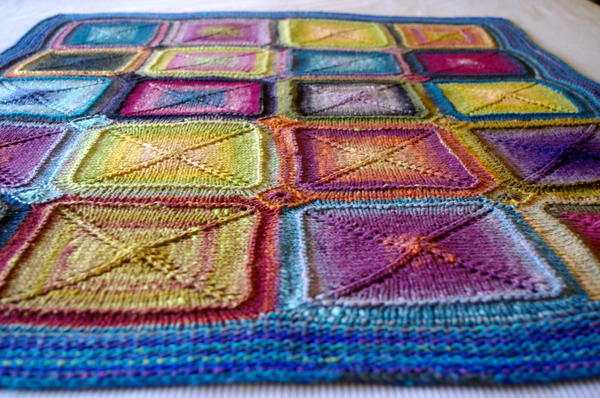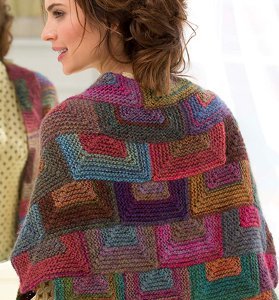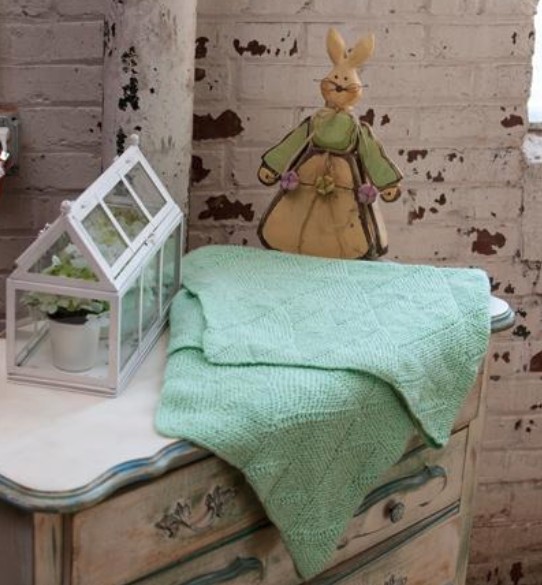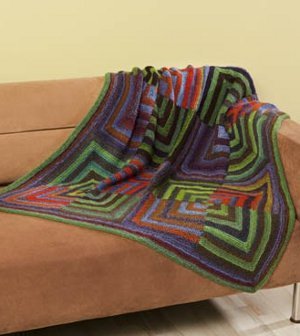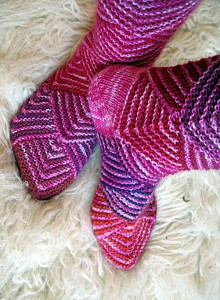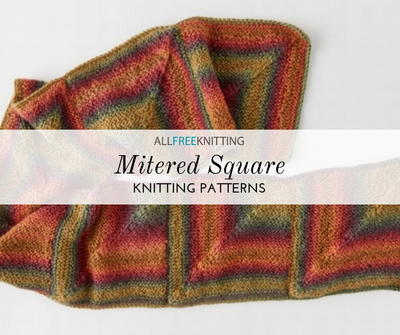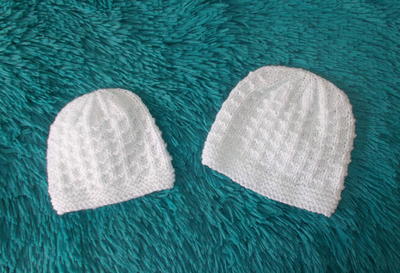Modular Knitting 101: How to Knit a Mitered Square
Also called domino knitting or number knitting, this clever knitting style will give you intricate and colorful finished products that are easy to create!

If you've been hanging around the knitting world lately, you've probably noticed that modular knitting has been gaining some popularity. You've possibly heard modular knitting under numerous other names, too. Some people call it number knitting, others call it domino knitting. No matter the name, this trendy knitting technique is a fun and easy way to make visually stunning fabrics that will impress.
Modular knitting is basically what it sounds like -- any form of knitting that joins multiple pieces of knit fabric together by picking up stitches. But if you've been in the knitting game for a while, you probably know that the most popular form of modular knitting it the mitered square.
These fun squares are made by creating decreases in the center of your knitting to make a square that appears to be made out of two triangles. A single seam runs diagonally down the middle, and you can easily create fun color work that looks absolutely magnificent as an afghan or a scarf.
New to mitered squares? Jump to the mitered square pattern here.
What Is Modular Knitting?
Modular knitting is an umbrella term that encompasses a wide range of styles, shapes, and designs, but the thing they all have in common is that the final knitted fabric is composed of multiple modules or knitted pieces that fit together.
The most common type of modular knitting is mitered knitting. Also sometimes called domino knitting, number knitting, or simply just modular knitting, this style is often used for knitting blankets. Unlike granny squares, which are typically sewn together, mitered squares joined by picking up stitches from one of the edges of the previous square.
Mitered squares can also be used to create pillows, like this Mod Mosaic Pillow. These squares are easily recognizable from the diagonal row of decreases through the center of the square and how the stitches go in two different directions in the two halves of the square.
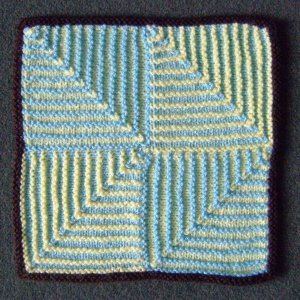
Virginia Woods Bellamy and Number Knitting
The math and geometric planning behind modular knitting is really the brainchild of Virginia Woods Bellamy who filed a patent in 1945 for a style of knitting that she called "number knitting." This very thorough patent outlines the basic mathematics of number knitting or modular knitting with the example of a blanket made out of mitered squares. The chart below was included in the patent, and it shows how truly versatile modular knitting can be with the addition of simple colorwork.

In this patent, Bellamy gives particular instructions for the order in which the squares should be knit -- starting from the center and working outwards in a counterclockwise spiral. Additionally, garter stitch edges form a border around the outside of the blanket, and four more mitered squares make up the corners.
Bellamy also gives some specific rules for what can be considered number knitting. For example, she says that the modules of number knitting must be joined by picking up stitches from the previous module instead of sewing them together or joining them with a Kitchener stitch. Over time, as modular knitting has grown in popularity, these rules have become more like guidelines; modular knitting nowadays encompasses a wide range of knitting styles and shapes.
Click here to read Virginia Woods Bellamy's patent for Number Knitting.
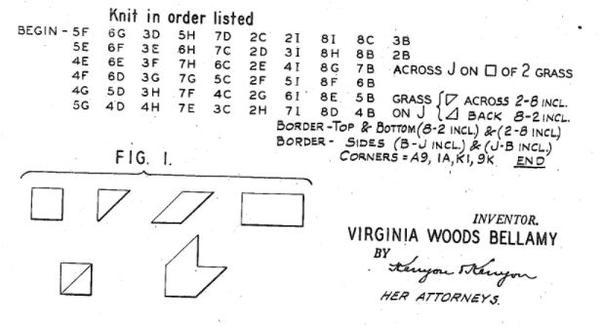
Common Types of Modules
Square Modules (Mitered Squares)
Square modules or mitered squares are by far the most common type of knit module because they're so simple to make, and they look stunning. Shown above, mitered squares are distinct because of the seem that runs diagonally down the center. And with a little colorwork, the possibilities are endless.
Photos Courtesy of Georgie from tikkiknits.com
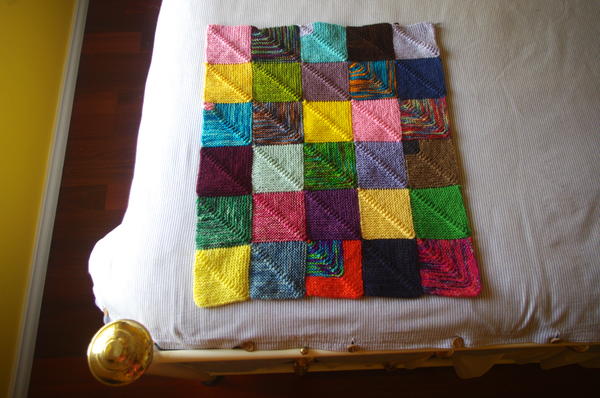
Triangular Modules
Similar to how square modules can create visually stunning blankets through angular colorwork, triangular modules are great because you can use the same technique to create hexagonal and octagonal designs. While the order of knitting triangular modules is less set-in-stone as it is with mitered squares, these modules are versatile in their own right and still very easy to knit.
Other Types of Modules
Vortex Modules: Complex, beautiful, and versatile, vortex modules are great for novelty knits and gifts. Check out this example of a vortex style module in action.
Shell or Scallop Modules: These modules are simply gorgeous, and they can be sued to create some very stunning visual illusions. This image below from Carol of Tall Tales from Kansas is a great example of shell-shaped modules, joined together to form one gorgeous piece of fabric.
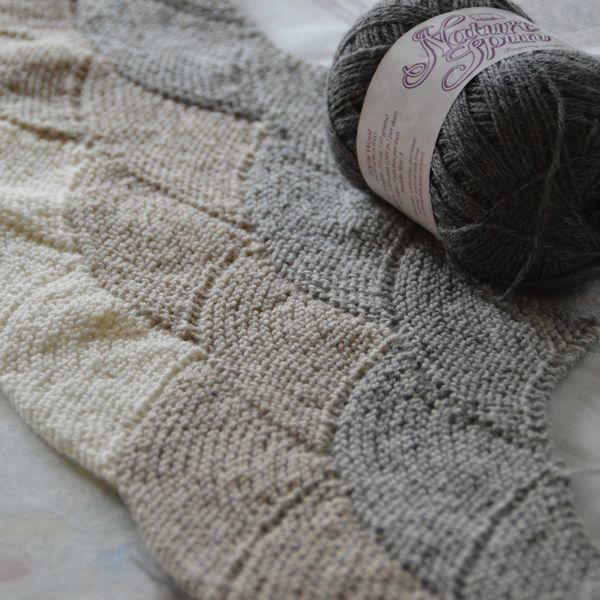
How to Knit a Mitered Square (Garter Stitch)
Instructions:
- CO an even number of stitches longtail.
For this example, we will use 48 stitches. - Row 1 (WS): K across the entire row, placing a stitch marker after the 24th stitch (exactly halfway through the row).
- Row 2 (RS): K up to two stitches before the stitch marker.
K2tog, slip the marker, SSK
Knit to the end - Repeat until you get down to the row with only two stitches. This should be a right side row.
K2tog and bind off.
Modular Knitting Patterns
Amazing Mitered Shawl
Many Mitered Baby Blanket
Mod Mitered Blanket
Winter Blues Mitered Mittens
Rose Diamond Socks
Have you tried modular knitting? Let us know in the comments!

